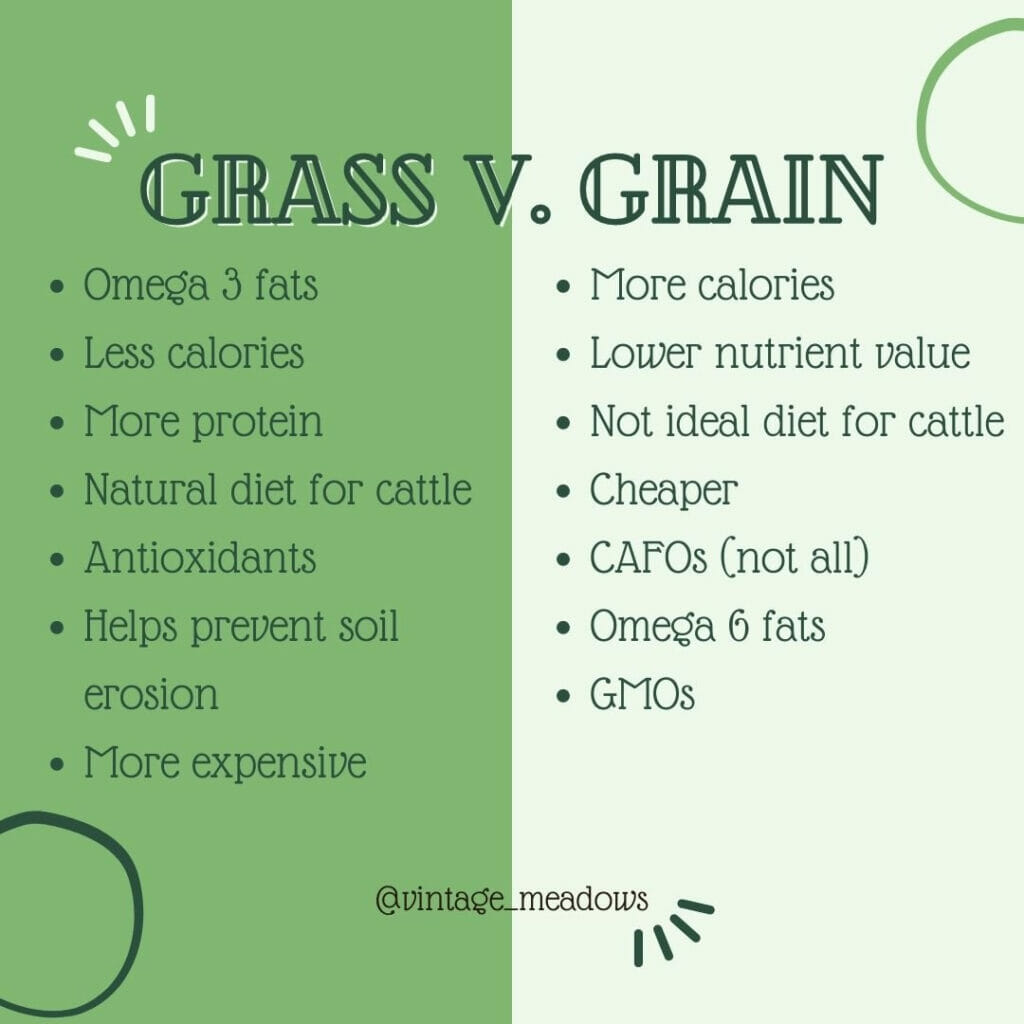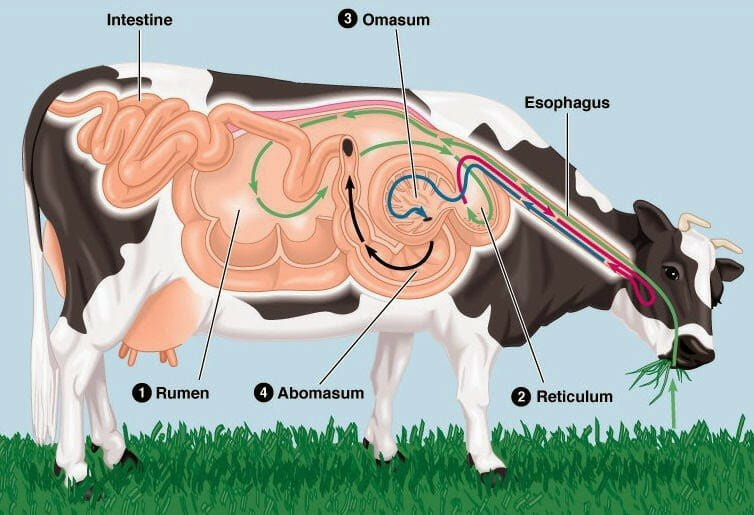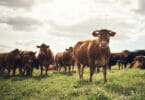I’ve reported on some of the deceptive marketing tactics before that the food and meat industry does to trick people into what they are purchasing and eating, so you can check that out here.
In this report, I wish to share the differences between the conventional grain-fed and feedlot beef offered at most stores and restaurants, and the grass-fed beef that is simply not sold at most stores in the United States. However, as I referenced above, a lot of the so-called “grass-fed beef” at the store is not genuine due to the regulatory loopholes the government allows.
I purchase my beef, and other meats, and raw dairy, at a local farm not too far from where I live. You can find one nearest you or have amazing farm quality delivered to you if you click the link below (I do make a small commission if you decide to use my link):
SEE: How To Find A Local, Organic, Sustainable, Regenerative, Decentralized Farm To Order From
New Study Shows That Regenerative Agriculture Boosts Nutrient Density
For a more thorough explanation into the differences in the type of beef on offer, Destiny Schrock from Vintage Meadows in Goshen, Indiana, the farm that I order from, wrote up a succinct article explaining the key differences that I think is worth reading.
The following is written by Destiny Schrock:
In recent years, there has been a lot of buzz around the terms grassfed and grainfed beef. Some are polarized about the issue and swear that one is better than the other while others say there’s no significant difference. Vintage Meadows’s primary output is our 100% grassfed beef products, which we are passionate about producing in an ethical and nutritionally exceptional way. This article will define the label “grassfed” as well as describe the differences between grassfed and grainfed and why we only raise 100% grassfed beef. Our intent is not to convince you that one is superior to the other, but only to present the facts, empowering readers to do their own research and form their own opinions!
Context
Cattle are ruminant animals, which means they have four stomachs and their digestion is a process. Cattle need grassy forages to survive. There’s no such thing as a 100% grainfed cow. All beef used to be grassfed, before producing grain was as cheap and easy as it is today with the help of GMO crops, pesticides, and large equipment. Today, grains, including corn and soybeans, make up about 10% of the average beef cow’s diet.
Companies throw around the “grassfed” or “grass finished” label. Due to a lack of regulation, any cow that has eaten grass at some point in its life can be labeled “grassfed.” What you want to be looking for is 100% grassfed. Numbers don’t lie! Organic grasses are important if you’re looking to avoid chemicals in your beef. Both grassfed and grainfed beef, if not organic, can be laden with chemicals depending on pesticides used on grass, hay, or grain crops.
Some people prefer the taste of grainfed beef over grassfed; due to the higher fat content, the flavor is certainly different. However, others will say the exact opposite: that grainfed beef is bland and fatty, while grassfed beef reveals the true flavor of beef.
One other important thing to note about Americans’ beef is that currently, any imported meat that passes through a USDA inspection is allowed to have a “Product of USA” label. That means meat from Canada, Mexico, and South America, labeled as originating in the US, is in our grocery stores, and consumers are none the wiser. Thankfully, this loophole is in the process of being changed in Congress at the time of this article being written. Read more about this here.
Grainfed Beef
First, let’s take a look at grainfed beef – eaten by the majority of red meat-eating Americans. In addition to the primary diet of hay, producers feed their cattle wheat, soybeans, and corn to increase energy levels which shortens production time and saves money. Grainfed beef has whiter colored fat and typically has more marbling, although not always. Because of their diet, grainfed beef has more calories, but less protein, less healthy fats, no antioxidants, and less overall nutrition. It’s also high in Omega 6 fats – the kind you get from eating processed food and a huge contributor to heart disease.
In an effort to produce affordable beef in America, cattle are fed grain (cheap to produce) and often raised in feedlots known as CAFOs (concentrated animal feeding operations). While not all grainfed cattle are raised in CAFOs, a large majority of the grainfed beef consumed by Americans is. These operations are notorious for inhumane treatment of their animals as well as pumping them full of antibiotics to preserve health. This practice not only lessens the quality of the meat, but it also ends up contaminating water with the harmful chemical and medication waste. One article suggested that commercial beef could contribute to antibiotic resistance in people who regularly eat this quality of meat.
It’s safe to assume that most grainfed beef these days consume GMO crops like corn or soybeans. “GMO’s or genetically modified organisms are plants that have had their genetic structure changed to live even after being sprayed with glyphosate (a toxic weed killer). It kills the grass and weeds around them, but not the crops. These traces of glyphosate end up being eaten by the animal in their feed, and then eaten by you” (Ballard). A lot of food in the US contains GMOs, but that does not change the fact that they are unnatural and that our bodies cannot digest them normally.

One cattle farmer described the American beef industry:
“US raised beef is largely produced on farms just like mine all over the country then those cattle are sold and shipped out West to a feedlot facility where they are grain fed a scientifically balanced diet for a specific time before going to one of the big 4 meat processors in the United States. These 4 companies process, control and ship 85% of all beef in the United States.
And that’s the meat you find in your grocery store. Processed and packed in black plastic containers in long strings you never can seem to break up when it cooks. You don’t know where it came from and next to nothing about its life.
That’s your grain fed supermarket meat” (Ballard).
Grassfed Beef
100% grassfed cattle (which is what Vintage Meadows produces) have had access to pasture their whole lives and have never had grain. “Allowing grass-fed cows to roam on pastures enables them to participate in their natural behavior, choosing the foods they want to eat and not being forced to overeat grains to make them gain weight more quickly” (TNI, 2022).
The beef tends to be leaner with yellower fat. Cows roam on pasture, where they develop more muscle and less fat. This means grassfed beef has less calories than grainfed and much more protein. Grassfed beef has significantly higher levels of Omega 3 fatty acids than grainfed beef. Omega 3 fats are essential to human health, promoting metabolic, cognitive, and cardiovascular health.
Additionally, grassfed beef has powerful antioxidants that don’t exist in grainfed beef. The diveristy of plants consumed by grassfed cattle contributes to high levels of antioxidant-rich phytonutrients. “We reap the benefits when we consume this antioxidant-rich meat, which includes anti-inflammatory, anti-carcinogenic, and cardioprotective activity. These phytochemicals also protect the meat from oxidation that causes inflammation and damage to cells, proteins, and fats—a leading cause of chronic disease and aging” (TNI, 2022).
Grazing cattle helps with soil erosion, making the land more durable and sustainable, especially in cases of flooding or drought. Through something we call regenerative agriculture, the cattle’s manure naturally fertilizes the land and “returns nutrients and healthy microbes to the soil, improving the biodiversity and health of the surrounding ecosystem” (TNI, 2022). Additionally, healthy soil and grasses help trap carbon dioxide, which mitigates the effects of the increased methane production from their longer lifespans.
Grassfed beef is typically more expensive than grainfed beef, due to the longer production time. 100% grassfed cattle also require a lot more land to produce, which contributes to the higher price tag. Overall, grassfed beef is full of important nutrients and even has environmental and agricultural benefits.
Conclusion
The biggest factor in the quality of your beef is the way the cow was raised and its health at the time of slaughter. While 100% grassfed beef raised without chemicals, pesticides, or antibiotics does have higher nutrient value, there are worse things out there than organic grainfed beef. For some, it comes down to a matter of flavor/texture preference or wanting the absolute best nutrition out there. Vintage Meadows is passionate about producing the highest quality product with maximum health benefits and no cut corners. For us, that means 100% grassfed beef that feeds you and your family, contributing to your physical and cognitive health.

References
Owens & Purser. (2021, July 16). Grain-Fed vs Grass-Fed Beef- What’s the Difference? NC Cooperative Extension. https://union.ces.ncsu.edu/2021/07/809396/
TNI Editorial Team. (2022, August 31). Reviewed by Dr. Jennifer Hughes, MD. Grass Fed vs Grain Fed: Which Beef is Best? The Nutrition Insider. https://thenutritioninsider.com/wellness/grass-fed-vs-grain-fed/
Ballard, R. (n.d.). Grass fed beef vs grain fed: Your unbiased guide. Feast and Farm. https://feastandfarm.com/grass-fed-beef-vs-grain-fed/
Flynn, D. (2023, March 7). “Product of USA” to mean something again. Food Safety News. https://www.foodsafetynews.com/2023/03/product-of-usa-to-mean-something-again/#:~:text=The%20voluntary%20%E2%80%9CProduct%20of%20U.S.A.,through%20a%20USDA%2Dinspected%20plant.
AUTHOR COMMENTARY
And I will send grass in thy fields for thy cattle, that thou mayest eat and be full.
He causeth the grass to grow for the cattle, and herb for the service of man: that he may bring forth food out of the earth;
Deuteronomy 11:15; Psalm 104:14
The King James Bible had it all settled centuries ago and millennia ago when it was first penned down. And then comes along the big corporations and all these supermarket chains, and restaurants that need to meet high demand, and thus begun the rise of conventionally-raised meats; coming at both a detriment to us and the animals, while the fat cats get richer.
A righteous man regardeth the life of his beast: but the tender mercies of the wicked are cruel.
Proverbs 12:10
Please, you need to support local farmers like these. If you are not farming and ranching yourself, then you need to do this instead and keep them afloat, and keep you healthy. As this country continues to fall apart a consolidation of even more power and control is occurring, and so being more decentralized can help counter that.
[7] Who goeth a warfare any time at his own charges? who planteth a vineyard, and eateth not of the fruit thereof? or who feedeth a flock, and eateth not of the milk of the flock? [8] Say I these things as a man? or saith not the law the same also? [9] For it is written in the law of Moses, Thou shalt not muzzle the mouth of the ox that treadeth out the corn. Doth God take care for oxen? [10] Or saith he it altogether for our sakes? For our sakes, no doubt, this is written: that he that ploweth should plow in hope; and that he that thresheth in hope should be partaker of his hope. (1 Corinthians 9:7-10).
The WinePress needs your support! If God has laid it on your heart to want to contribute, please prayerfully consider donating to this ministry. If you cannot gift a monetary donation, then please donate your fervent prayers to keep this ministry going! Thank you and may God bless you.









Great article. I know, right? God already set up a perfect system yet the money-hungry corporations want everything FAST, therefore messing up the original design. People have to reject these deceitful meats and support farmers that practice proper livestock raising and crop cultivation.
Proverbs 19:2
Also, that the soul be without knowledge, it is not good; and he that hasteth with his feet sinneth.
Winepress articles add to our knowledge. I just recently finally understood, thanks to the Lord, these verses in Proverbs 24 (specifically verse 10, by tying it to verse 5):
Proverbs 24:5, 10
5 A wise man is strong; yea, a man of knowledge increaseth strength.
10 If thou faint in the day of adversity, thy strength is small. (small because of laziness in researching or studying the Bible and other relevant topics, among other reasons)
1 Timothy 4:13
Till I come, give attendance to reading, to exhortation, to doctrine.
2 Timothy 2:15
Study to shew thyself approved unto God, a workman that needeth not to be ashamed, rightly dividing the word of truth.
What these verses tell me is that if Christians want to be strong, aside from watching our health and mental well-being, we have to increase our knowledge through reading, researching and studying many different areas, and cross-checking them with the King James Bible.
So true Lance:
Pro 2:1 My son, if thou wilt receive my words, and hide my commandments with thee;
Pro 2:2 So that thou incline thine ear unto wisdom, and apply thine heart to understanding;
Pro 2:3 Yea, if thou criest after knowledge, and liftest up thy voice for understanding;
Pro 2:4 If thou seekest her as silver, and searchest for her as for hid treasures;
Pro 2:5 Then shalt thou understand the fear of the LORD, and find the knowledge of God.
It’s a good idea to eat natural of
course but then man comes
along ( Your Government) experiments with nuclear bombs and suddenly you
have radio active isitopes in your milk and meat because someone ( most likely a congressional lobbyist) in dairyland decides to cut corners and allow their cows to feed on contaminated land rather then
continue to pay for high priced feed.
Hows about a warning label warning consumers?
This grass fed cow meat or milk may have consumed hazardious
radio active materials from contaiminated government land which may cause you a wide variety of cancers, lymophoma, hair loss, sterilization or damage to your DNA? Fairness dpesn’t always sound fair on the open market does it? But let
Say you had no morals or ethical standerds and
exported to parts of India….What would the populations response be?
There are cows that are not fed grains, but corn, and some are fed with feed. Since I’m moving to an apartment on the 15th of September, I now have access to farms, unlike in New York City (I’m moving to Rochester).